Pride month is a celebration of the LGBTQ+ community and its commitment to the fight for equality. Amid the festivities, we also want to raise awareness about the importance of increasing access to cancer screening and prevention for this community, and the barriers that many face while seeking care. Here are five things you may not know about how cancer affects the LGBTQ+ community:
1. HPV-related cancers are higher among gay and bisexual men.
The human papillomavirus (HPV) is a group of viruses, some of which are spread through sexual activity and can lead to at least six types of cancer, including cervical cancer, oropharyngeal cancer (cancer of the back of throat, including base of tongue and tonsils) and anal cancer. Some LGBTQ+-identifying individuals are at increased risk for these HPV-related cancers. For example, cisgender men who have sex with other men are more likely to develop anal cancer than cisgender men who have sex with cisgender women. Fortunately, HPV vaccination can help reduce your risk. It is recommended for anyone up to age 26 who did not receive the vaccine as a child. If the vaccine is given as recommended, it can prevent up to 90% of HPV-related cancers.1
2. Transgender people are less likely to be screened and more likely to have a negative health care experience.
Transgender people face many barriers and are at a disproportionately higher risk for some cancers, such as HPV-related cancers, than cisgender people.2 According to a JAMA study, 33% of transgender individuals reported having negative experiences with health workers.3 Although there is a scarcity of trans–inclusive research and data overall, these studies point to discrimination and a need to better inform the medical community on trans health, including cancer screening guidelines and how gender-affirming hormone treatment relates to cancer risk. Transgender people are also less likely to get screened for cancer partly due to stigma, gender dysphoria, and/or the need to address body parts they no longer identify with.
3. Breast, cervical and ovarian cancer rates are higher among lesbian, bisexual and queer women.
According to the American Cancer Society, lesbians and bisexual women may be more likely to get breast, cervical and ovarian cancers in comparison to heterosexual women. Barriers such as fear of discrimination, lack of health insurance and negative experiences with medical providers contribute to a lower rate of routine check-ups and detecting cancer. Risk factors, including higher levels of tobacco and alcohol use, higher rates of obesity and/or a higher likelihood of delaying or not having kids also contribute to these increased cancer rates.4
4. LGBTQ+ people experience barriers to accessing care.
LGBTQ+-identifying individuals are more likely to face barriers to health care related to transportation, employment, and quality of care, which can make getting routine cancer screenings difficult.5 These barriers are due, in part, to systemic homophobia and transphobia in the medical community and society, which may contribute to lower screening rates.
5. Many LGBTQ+ people fear discrimination from the health care system.
Members of the LGBTQ+ community may fear being discriminated against while receiving health services, which can lead some people to delay or avoid getting routine cancer screenings. In a study, nearly 1 out of 5 LGBTQ+ individuals reported avoiding health care services due to fear of being discriminated against.6
Delaying screenings, or avoiding them all together, can result in cancers being missed or diagnosed at later stages. It is important for health providers to recognize this barrier to care and practice empathy when engaging with all patients, but especially those who may mistrust the health care system.
If you are a lesbian, gay, bisexual, transgender or queer person looking for additional resources or an LGBTQ+-friendly health care provider, visit the Prevent Cancer Foundation’s website.
The Prevent Cancer Foundation is committed to ensuring everyone can access preventive services and essential care. In an effort to address cancer disparities in the LGBTQ+ community, the Foundation supported 10 community grant projects in 2022 dedicated to increasing cancer prevention and early detection in LGBTQ+ communities across the U.S., from Palm Springs, California to New Hyde Park, New York. These grantees work diligently to provide their communities with necessary resources to address barriers that prevent members of the LGBTQ+ community from receiving routine cancer screenings and vaccinations. Learn more about their work.
1HPV and Cancer. National Institutes of Health National Cancer Institute. 4 April 2021. https://www.cancer.gov/about-cancer/causes-prevention/risk/infectious-agents/hpv-and-cancer
2“Trans and gender-diverse people face higher risk of some cancers, and a higher risk of those cancers being missed.” VaccinesWork. 31 March 2023, https://www.gavi.org/vaccineswork/trans-and-gender-diverse-people-face-higher-risk-some-cancers-and-higher-risk-those
3Leone AG, Trapani D, Schabath MB, et al. Cancer in Transgender and Gender-Diverse Persons: A Review. JAMA Oncol. 2023;9(4):556–563. doi:10.1001/jamaoncol.2022.7173
4Cancer Facts for Lesbian and Bisexual Women.” Cancer.org, 27 Aug. 2021, www.cancer.org/cancer/risk-prevention/understanding-cancer-risk/cancer-facts/cancer-facts-for-lesbian-and-bisexual-women.html.
5“Cancer Facts for Gay and Bisexual Men.” American Cancer Society. 27 Aug 2021. https://www.cancer.org/cancer/risk-prevention/understanding-cancer-risk/cancer-facts/cancer-facts-for-gay-and-bisexual-men.html
6“AACR Cancer Disparities Progress Report.” American Association for Cancer Research. 2022. https://cancerprogressreport.aacr.org/disparities/cdpr22-contents/cdpr22-the-state-of-cancer-health-disparities-in-2022/

No Comments